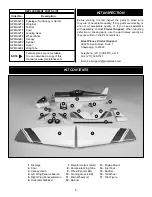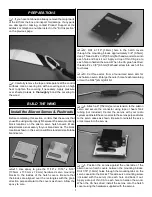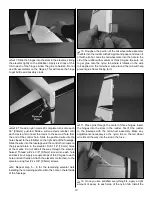
19
a mixture of liquid dish soap and warm water—about one
teaspoon of soap per gallon of water. Submerse the decal
in the soap and water and peel off the paper backing. Note:
Even though the decals have a “sticky-back” and are not the
water transfer type, submersing them in soap & water allows
accurate positioning and reduces air bubbles underneath.
❏
3. Position decal on the model where desired. Holding
the decal down, use a paper towel to wipe most of the
water away.
❏
4. Use a piece of soft balsa or something similar to
squeegee remaining water from under the decal. Apply the
rest of the decals the same way.
GET THE MODEL READY TO FLY
Install and Operate the Motor Battery
IMPORTANT: If using multiple battery packs that are
connected with an adapter, never charge the batteries
together through the adapter. Always charge each battery
pack separately. Charge the batteries, then read the
following precautions on how to connect multiple packs for
fl ying the model:
BATTERY PRECAUTIONS
There are two ways to connect multiple battery packs: In
Series and in Parallel.
1. Connecting batteries in “Series” means to connect the
(+)’s to the (–)’s and the (–)’s to the (+)’s. This combines the
voltages of the batteries, but the capacity remains the same.
2. Connecting batteries in “Parallel” means to connect
the (+)’s to the (+)’s and the (-)’s to the (-)’s. This combines
the capacities of the batteries, but the voltage remains
the same.
NEVER connect battery packs with different voltages in
parallel! Only combine them in series. Otherwise, the
batteries with lower voltage will try to “equalize” with the
batteries that have a higher voltage. Current will fl ow from
the higher voltage battery into the lower one, essentially
“charging” the lower voltage battery pack. This situation will
likely cause heat and possibly a fi re.
NEVER connect battery packs with different capacities in
series or in parallel.
Check the Control Directions
❏
1. Turn on the transmitter and receiver and center the
trims. If necessary, remove the servo arms from the servos
and reposition them so they are centered. Reinstall the
screws that hold on the servo arms.
❏
2. With the transmitter and receiver still on, check
all the control surfaces to see if they are centered. If
necessary, adjust the clevises on the pushrods to center
the control surfaces.
❏
3. Make certain that the control surfaces and the carburetor
respond in the correct direction as shown in the diagram.
If any of the controls respond in the wrong direction, use
the servo reversing in the transmitter to reverse the servos
connected to those controls. Be certain the control surfaces
have remained centered. Adjust if necessary.
Set the Control Throws
Use a Great Planes AccuThrow (or a ruler) to accurately
measure and set the control throw of each control surface
as indicated in the chart that follows. If your radio does not
have dual rates, we recommend setting the throws at the
low rate setting.
These are the recommended control surface throws:
ELEVATOR
HIGH RATE
LOW RATE
3/4"
[19mm]
10 deg
Up
3/4"
[19mm]
10 deg
Down
5/16"
[8mm]
5 deg
Up
5/16"
[8mm]
5 deg
Down
RUDDER
2-1/2"
[64mm]
22 deg
Right
2-1/2"
[64mm]
22 deg
Left
1-1/2"
[38mm]
13 deg
Right
1-1/2"
[38mm]
13 deg
Left
AILERONS
1/2"
[13mm]
12 deg
Up
1/2"
[13mm]
12 deg
Down
1/4"
[6mm]
6 deg
Up
1/4"
[6mm]
6 deg
Down
NOTE: The throws are measured at the widest part of the
elevators, rudder and ailerons.
IMPORTANT: The Revolver ARF has been extensively
fl own and tested to arrive at the throws at which it fl ies
best. Flying your model at these throws will provide you
with the greatest chance for successful fi rst fl ights. If, after
you have become accustomed to the way the Revolver
fl ies, you would like to change the throws to suit your taste,
that is fi ne. However, too much control throw could make
the model diffi cult to control, so remember, “more is not
always better.”




















